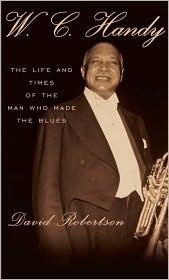
 W.C. Handy: The Life And Times Of The Man Who Made The Blues by David Robertson. Knopf, 2009.
W.C. Handy: The Life And Times Of The Man Who Made The Blues by David Robertson. Knopf, 2009.
In Memphis there is a statue of W.C. Handy, “the Father of the Blues,” in Handy Park on Beale Street. Handy named his autobiography, The Father of the Blues but, according to author David Robertson in his new biography of Handy,
“He was not properly the Father of the Blues, as he was later acclaimed, but he was certainly the maker of the blues in the early twentieth century. He made the blues as a consciously composed art—working as an ‘American composer’—and he also made them in that word’s sense of guaranteeing their success and of commercially promoting this music.”
William Christopher Handy was born in 1873 in Florence, Alabama and learned the cornet, which was the electric guitar of its day—an essential part of any band that wanted to be heard—and moved to Clarksdale, Mississippi when he was 29. At a train station one night waiting to catch the train back to Clarksdale, Handy heard “the weirdest music I had ever heard.” This was Handy’s first exposure to what is now known as “Delta blues.”
Author Robertson elaborates, “While Handy and his musicians took an intermission to smoke cigarettes, a rustic-looking black string band consisting of players of a bettered bass, mandolin, and guitar, led ‘by a long-legged chocolate boy,’ in Handy’s description, took the stage and began to play the new music later known as the blues… ‘a rain of silver dollars began to fall around the outlandish, stomping feet’… ‘my idea of what constitutes music was changed by the sight of that silver money cascading around the splayed feet of a Mississippi string band.’”
This was Handy’s blind light on the road to Damascus. Handy moved to Memphis, where he toured on the black vaudeville circuit run by the Brasso family through their Theater Owners Booking Association, known as the “TOBA circuit” and often referred to as the “Tough On Black Asses” circuit.
In Memphis, Handy teamed up with Harry H. Pace, a former banker who became his business partner. Handy needed a partner who could handle business and Pace played a major role in the success of Handy as the two established a publishing company and promoted Handy’s songs. This was the era of sheet music, so music had to be written down and printed on sheet music in order to make any money. Handy’s first success was “Memphis Blues,” originally written for Boss Crump, the legendary Mayor of Memphis for many years.
Other Handy songs included “Yellow Dog Blues,” “Joe Turner Blues,” “Beale Street Blues,” and “St. Louis Blues,” which became one of the most performed songs of the early twentieth century.
In 1918 Handy and Pace moved to New York where Pace established Black Swan Records in 1921, the first record label owned by African-Americans. The label only lasted two years but was the forerunner of Motown Records.
The book details Handy’s loss of the publishing of “Memphis Blues” by two white businessman as well as Handy obtaining the rights back in 1940. The music business is a difficult business and being an African-American made it even more difficult.
Author Robertson notes that during his career Handy “learned three hard, constructive lessons. First, never sell a copyright….Second, he learned that even should he succeed in keeping the copyright and obtaining an honest publisher with national distribution for this sheet music, he needed his compositions to be identified with a white performer to gain national acceptance by retailers or audiences…[the] third lesson learned by the composer from the loss of ‘The Memphis Blues’ was that he was in sore need of a trustworthy partner with a greater business sense than his own.”
Henry Pace left the record business when Black Swan folded in 1923 and returned to the banking business, where he had a successful career. W.C. Handy went blind and his songs fell out of favor as R&B became the preferred sound for African-Americans. He died in 1958 and his funeral “was one of the largest public occasions in the history of New York City to that decade,” according to author Robertson.
W.C. Handy by David Robertson is a valuable addition to the history of the blues and Handy’s role in popularizing that genre. And after reading this biography, you may be inspired to go to Memphis and see the statue of W.C. Handy that was put up in 1931.

About the Author
Don Cusic is Professor of Music Business at Belmont University. He has authored 18 books, including his most recent “Discovering Country Music.”View Author Profile


